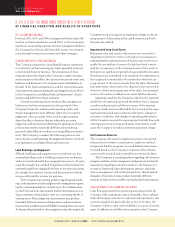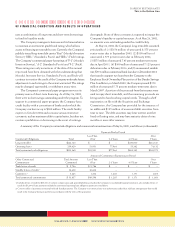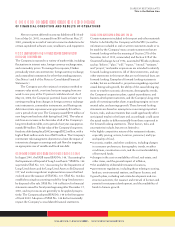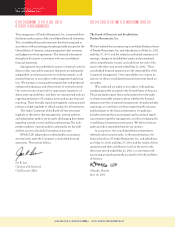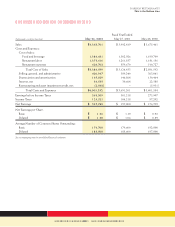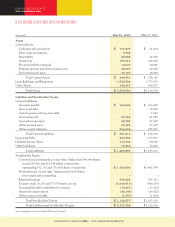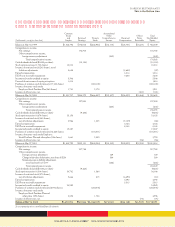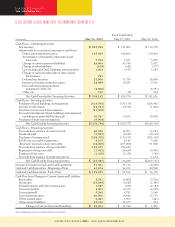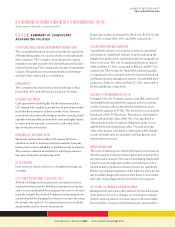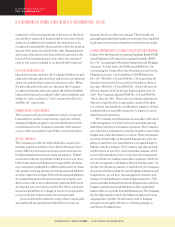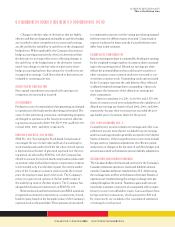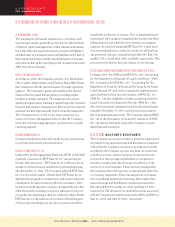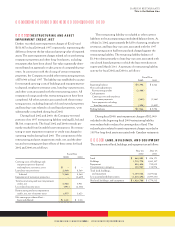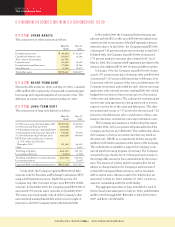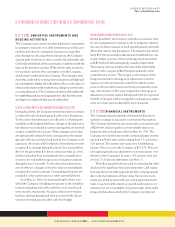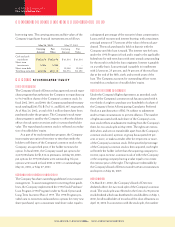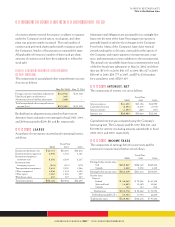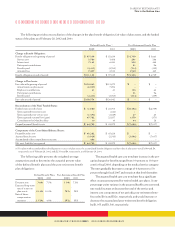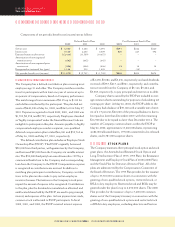Red Lobster 2002 Annual Report Download - page 33
Download and view the complete annual report
Please find page 33 of the 2002 Red Lobster annual report below. You can navigate through the pages in the report by either clicking on the pages listed below, or by using the keyword search tool below to find specific information within the annual report.
Notes to Consolidated Financial Statements
comparison of the carrying amount of the assets to the future
net cash flows expected to be generated by the assets. If such
assets are considered to be impaired, the impairment to be
recognized is measured by the amount by which the carrying
amount of the assets exceeds their fair value. Restaurant sites
and certain other assets to be disposed of are reported at the
lower of their carrying amount or fair value, less estimated
costs to sell, and are included in net assets held for disposal.
Unearned Revenues
Unearned revenues represent the Company’s liability for gift
cards and certificates that have been sold but not yet redeemed
and are recorded at their expected redemption value. When
the gift cards and certificates are redeemed, the Company
recognizes restaurant sales and reduces the deferred liability.
Unearned revenues are included in other current liabilities and,
at May 26, 2002, and May 27, 2001, amounted to $56,632
and $38,145, respectively.
Self-Insurance Reserves
The Company self-insures a significant portion of expected
losses under its workers’ compensation, employee medical,
and general liability programs. Accrued liabilities have been
recorded based on the Company’s estimates of the ultimate
costs to settle incurred and incurred but not reported claims.
Income Taxes
The Company provides for federal and state income taxes
currently payable as well as for those deferred because of tem-
porary differences between reporting income and expenses
for financial statement purposes versus tax purposes. Federal
income tax credits are recorded as a reduction of income taxes.
Deferred tax assets and liabilities are recognized for the future
tax consequences attributable to differences between the finan-
cial statement carrying amounts of existing assets and liabilities
and their respective tax bases. Deferred tax assets and liabilities
are measured using enacted tax rates expected to apply to tax-
able income in the years in which those temporary differences
are expected to be recovered or settled. The effect on deferred
tax assets and liabilities of a change in tax rates is recognized in
income in the period that includes the enactment date.
Income tax benefits credited to equity relate to tax benefits
associated with amounts that are deductible for income tax
purposes but do not affect net earnings. These benefits are
principally generated from employee exercises of non-qualified
stock options and vesting of employee restricted stock awards.
Derivative Instruments and Hedging Activities
In June 1998, the Financial Accounting Standards Board (FASB)
issued Statement of Financial Accounting Standards (SFAS)
No. 133, “Accounting for Derivative Instruments and Hedging
Activities.” In June 2000, the FASB issued SFAS No.138,
“Accounting for Certain Derivative Instruments and Certain
Hedging Activities – an Amendment of FASB Statement
No. 133.” SFAS No. 133 and SFAS No. 138 require that all
derivative instruments be recorded on the balance sheet at
fair value. SFAS No. 133 and SFAS No. 138 are effective for
all fiscal quarters of all fiscal years beginning after June 30,
2000. The Company adopted SFAS No. 133 and SFAS No.
138 on May 28, 2001. There were no transition adjustments
that were required to be recognized as a result of the adop-
tion of these new standards, and therefore, adoption of these
standards did not materially impact the Company’s consoli-
dated financial statements.
The Company uses financial and commodities derivatives
in the management of interest rate and commodities pricing
risks that are inherent in its business operations. The Company’s
use of derivative instruments is currently limited to interest rate
hedges and commodities futures contracts. These instruments
are structured as hedges of forecasted transactions or the vari-
ability of cash flow to be paid related to a recognized asset or
liability (cash flow hedges). The Company may also use finan-
cial derivatives as part of its stock repurchase program, which
is more fully described in Note 10. No derivative instruments
are entered into for trading or speculative purposes. All deriva-
tives are recognized on the balance sheet at their fair value. On
the date the derivative contract is entered into, the Company
documents all relationships between hedging instruments and
hedged items, as well as its risk-management objective and
strategy for undertaking the various hedge transactions. This
process includes linking all derivatives designated as cash flow
hedges to specific assets and liabilities on the consolidated
balance sheet or to specific forecasted transactions. The Company
also formally assesses, both at the hedge’s inception and on an
ongoing basis, whether the derivatives used in hedging
transactions are highly effective in offsetting changes in
cash flows of hedged items.
DARDEN RESTAURANTS
This is the Bottom Line
Great Food and Beverage 30 Produce Great Results in 2002


